By Ho Sie Sie
Given Singapore’s warm climate, it will not come as a surprise that people are partial to the occasional glass of ice-cold beer. Or perhaps, more than an occasional glass. Beer production in Singapore is set to reach 200,000 metric tonnes by 2026. In 2021, Singapore was ranked 83rd among key markets across the world for beer production.1
Local giant Tiger Beer dominates the scene, and indeed has been doing so for decades. However, the history of beer making in Singapore isn’t limited to Tiger Beer. Another beer with a long history in Singapore is Anchor Beer. Both Tiger and Anchor beers are made by Asia Pacific Breweries (APB), who also produce another well-known local brand, ABC Stout.
Reliance on Imported Beer
Both Anchor and Tiger beers go back to the early 1930s. Before that, the beer consumed in Singapore was entirely imported.2 Some brands include Carlsberg (Scandinavia), Worthington (Britain) and Sakura (Japan). These beers were expensive, especially after accounting for transportation and other logistical costs. Beer in the 1930s cost an average of 20 cents, which might not seem like much but this was about half the daily standard wages for labourers back then (40 and 32 cents per day for men and women respectively).3
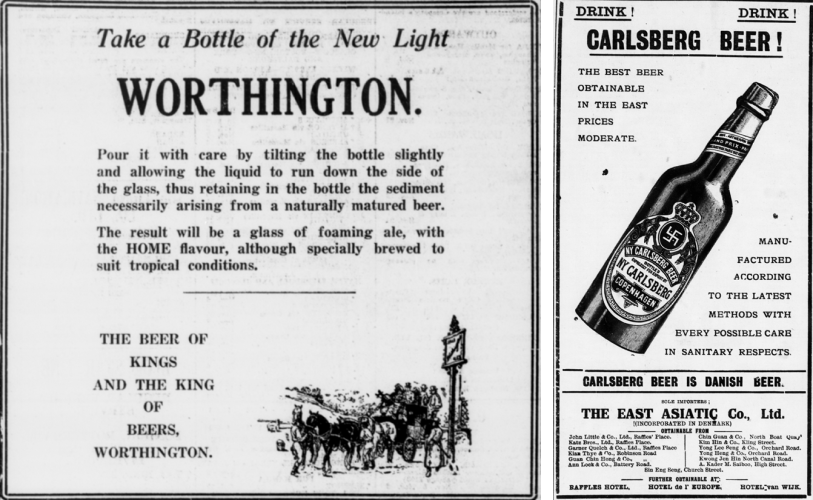 (Left) A 1930 Worthington advertisement. Image reproduced from “Worthington,” Straits Times, 28 October 1930, 1 (From NewspaperSG). (Right) A 1916 advertisement for Carlsberg. Image reproduced from “Drink! Drink! Carlsberg Beer!,” Singapore Free Press and Mercantile Advertiser (1884–1942), 9 May 1916, 9. (From NewspaperSG).
(Left) A 1930 Worthington advertisement. Image reproduced from “Worthington,” Straits Times, 28 October 1930, 1 (From NewspaperSG). (Right) A 1916 advertisement for Carlsberg. Image reproduced from “Drink! Drink! Carlsberg Beer!,” Singapore Free Press and Mercantile Advertiser (1884–1942), 9 May 1916, 9. (From NewspaperSG).
Seeing a gap in the industry, The Straits Brewery Limited proposed in 1904 to start a brewery in Singapore.4 However, as promising as things sounded, the idea never got off the ground.
From Aerated Water to Liquid Gold
The story of local beer brewing in Singapore really starts with Fraser & Neave (better known as F&N), though the company was not set up to brew beer. Indeed, it didn’t take on this name until later. In 1883, Englishmen John Fraser and David Chalmers Neave founded the Singapore and Straits Aerated Water Company and by 1890, the company specialised in manufacturing “soda water, seltzer water, potass water, lemonade, tonic, ginger ale” for Singapore’s clubs, hotels and residences. From just 20 employees, the company grew to become one of the island’s largest companies with 63 employees and branches in other parts of Malaya and Asia by 1913.5 In 1898, the business went public and was renamed Fraser & Neave.6
The start of World War One (1914–18) saw F&N reducing capacity to survive and it took years after the war ended for it to recover. F&N then decided to partner with one of Holland’s most important breweries, Heineken. The partnership allowed both companies to further their development and expansion. Heineken was able to gain a foothold into Asia while F&N had access to Heineken’s technical expertise in brewing quality beer.7 This partnership led to the establishment of Malayan Breweries Limited, the first modern brewery (located behind Alexandra Brickworks) built in Singapore with a capital of $1 million in 1931.8
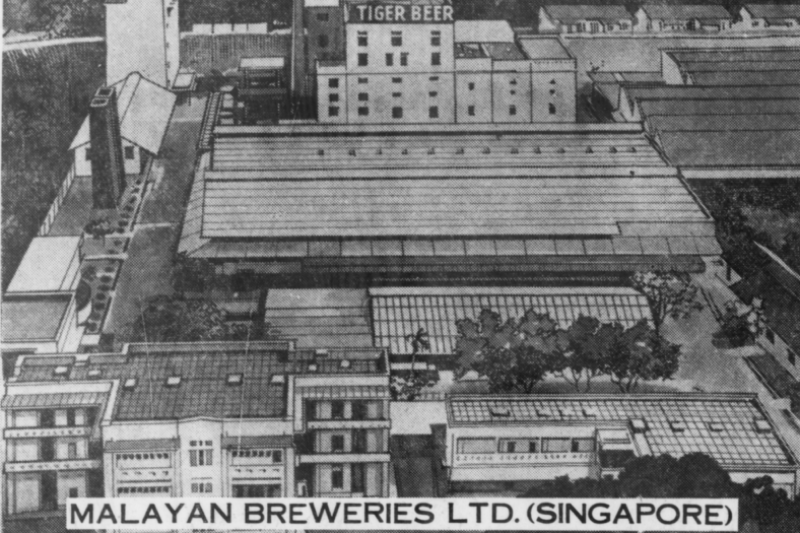 Malayan Breweries Limited was the first modern brewery built in Singapore behind Alexandra Brickworks, 1962. Source: Straits Times, 17 November 1962 © SPH Media Limited. Permission required for reproduction.
Malayan Breweries Limited was the first modern brewery built in Singapore behind Alexandra Brickworks, 1962. Source: Straits Times, 17 November 1962 © SPH Media Limited. Permission required for reproduction.
The happy product of that marriage was born in 1932 when Tiger Beer, a homegrown lager beer, made its debut. At its launch, beer was given away for free and “over two hundred guests … [were] given as much beer as they desired, and an eloquent tribute to the new beverage lay in the fact that many who were not regular drinkers asked for a second glass, while others had a third.”9
Tiger Beer was an instant success, particularly among British servicemen in Malaya due to its refreshing taste and affordable price. Within two years of its launch, Tiger Beer accounted for over two thirds of beer consumed in British Malaya.10
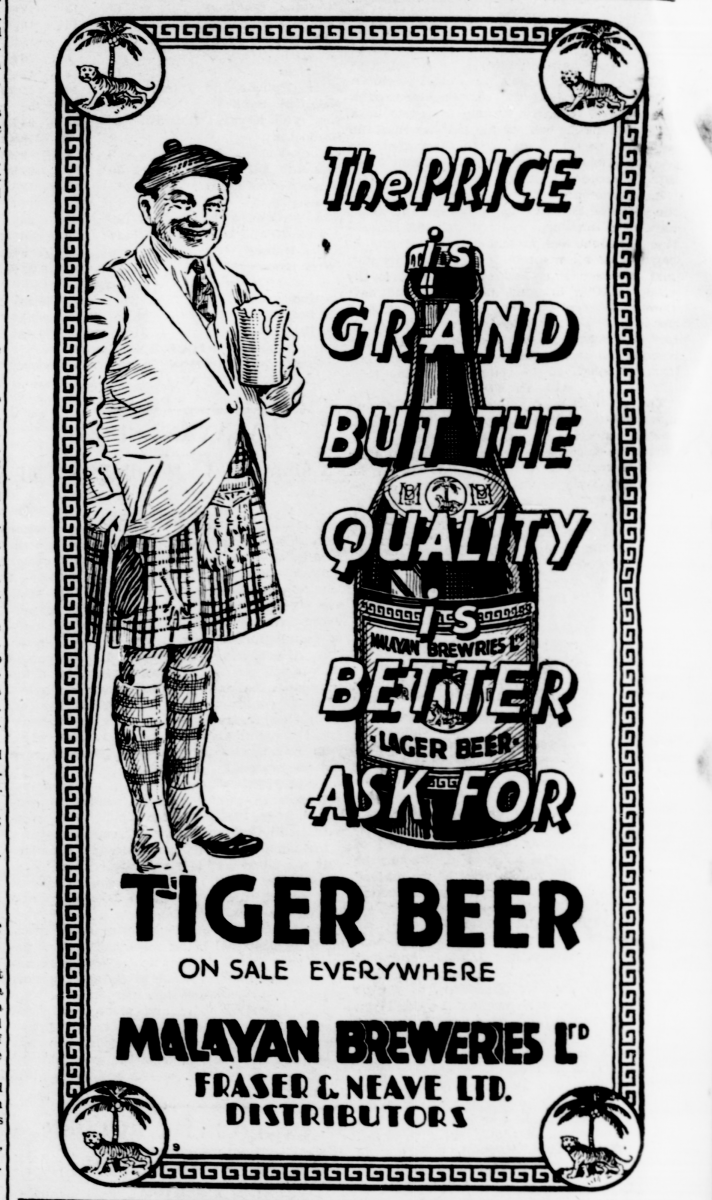 A 1932 advertisement for Tiger Beer. Image reproduced from “Tiger Beer,” Singapore Free Press and Mercantile Advertiser, 8 October 1932, 20. (From NewspaperSG).
A 1932 advertisement for Tiger Beer. Image reproduced from “Tiger Beer,” Singapore Free Press and Mercantile Advertiser, 8 October 1932, 20. (From NewspaperSG).
The success of Malayan Breweries was largely due to the technical expertise provided by Heineken, which had a 40 percent stake in the company. Besides its expertise in brewing, Heineken also brought in sophisticated laboratory facilities and highly trained personnel. These included master brewers and technical managers who maintained strict quality standards that was crucial to Tiger’s success.11
Time for a Tiger!
Tiger Beer was launched with the catchphrase “Time for a Tiger” in 1932. A tagline that is still familiar with many today, the phrase was subsequently made famous by British author Anthony Burgess who named his 1956 novel, Time for a Tiger. This book was the first instalment of his Malayan trilogy, The Long Day Wanes.12
By 1935, Malayan Breweries had turned its attentions toward exporting Tiger Beer, which had started to gain popularity beyond the Malayan market in countries like Hong Kong.13 It expanded its brewery twice – in 1937 and 1939 – to keep up with the growing demand.14
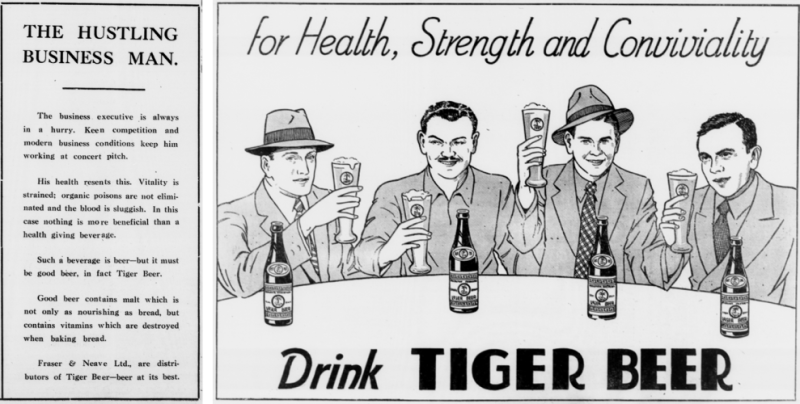 Tiger Beer was advertised as a nutritious health drink. (Left)Image reproduced from “The Hustling Business Man,” Straits Times, 1 December 1932, 13. (From NewspaperSG). (Right) Image reproduced from “Drink Tiger Beer,” Straits Times, 16 September 1935, 13. (From NewspaperSG).
Tiger Beer was advertised as a nutritious health drink. (Left)Image reproduced from “The Hustling Business Man,” Straits Times, 1 December 1932, 13. (From NewspaperSG). (Right) Image reproduced from “Drink Tiger Beer,” Straits Times, 16 September 1935, 13. (From NewspaperSG).
Tiger’s Rival
Malayan Breweries, however, was not alone in eyeing the local beer drinking market. In 1933, Archipelago Brewery Company (ABC) opened Singapore’s second brewery, which was also located along Alexandra Road. ABC was backed by Messrs O’Wehry and Co. of Batavia, and Becks Brewery from Germany, whose beers had been imported into Malaya since 1893. ABC also boasted a million-dollar set up and claimed to have a production capacity of 450,000 gallons of beer a year.
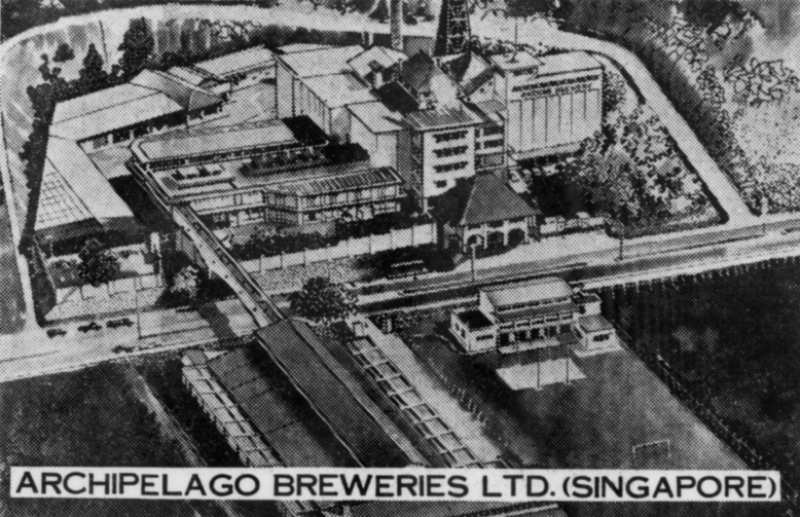 Archipegalo Brewery Company (ABC) was built at Alexandra Road in 1933. It was later acquired by Malayan Breweries. Source: Straits Times, 17 November 1962 © SPH Media Limited. Permission required for reproduction.
Archipegalo Brewery Company (ABC) was built at Alexandra Road in 1933. It was later acquired by Malayan Breweries. Source: Straits Times, 17 November 1962 © SPH Media Limited. Permission required for reproduction.
ABC became synonymous with its main brew, Anchor Beer, a light pilsener that used English hops and Australian malt.15 It also produced Diamond Pilsener, Goat’s Head Stout and ABC Stout. To promote Anchor, ABC partnered with the Phoenix Aerated Water Works to give the beer for free with each delivered order of Phoenix Aerated Water.16 ABC also worked with Phoenix Aerated Water Works for its retail distribution, which allowed Anchor to be delivered directly to customers at unchanged prices.17
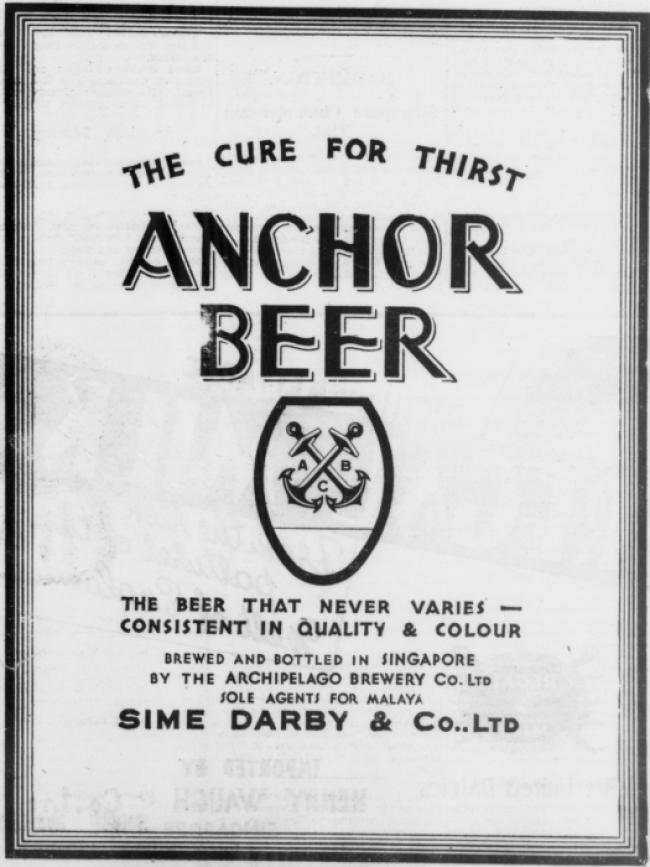 Advertisement for Anchor Beer. Image reproduced from “The Cure for Thirst,” Straits Times, 30 July 1934, 15. (From NewspaperSG).
Advertisement for Anchor Beer. Image reproduced from “The Cure for Thirst,” Straits Times, 30 July 1934, 15. (From NewspaperSG).
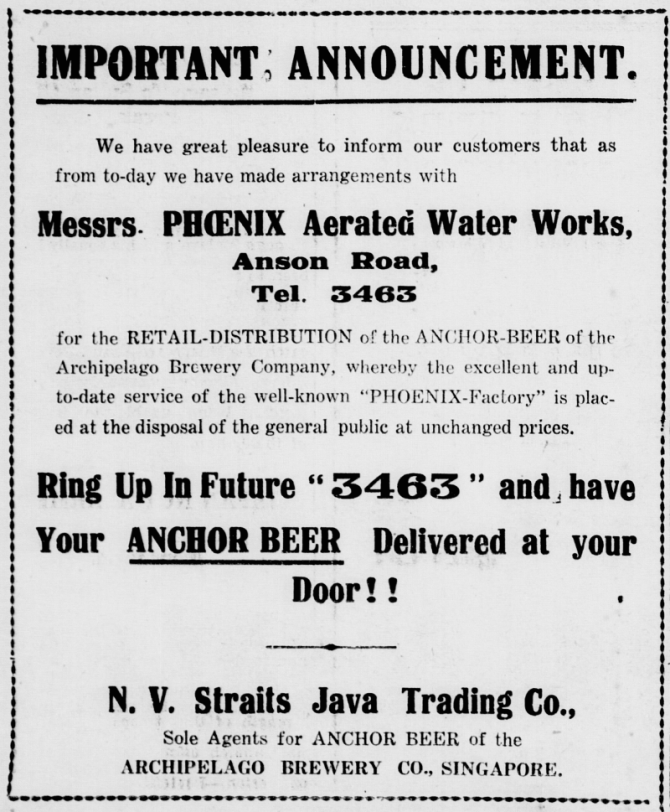 This notice was run in the Sunday Tribune announcing ABC’s partnership with Phoneix Aerated Water Works for the retail distribution of Anchor Beer. Image reproduced from “Importance Announcement,” Sunday Tribune, 21 January 1934, 2. (From NewspaperSG).
This notice was run in the Sunday Tribune announcing ABC’s partnership with Phoneix Aerated Water Works for the retail distribution of Anchor Beer. Image reproduced from “Importance Announcement,” Sunday Tribune, 21 January 1934, 2. (From NewspaperSG).
Beer Brewing During the Japanese Occupation
When war broke out in Europe in 1939, the Germans who were managing ABC left Singapore, putting hundreds of local employees at risk of losing their jobs. The Malayan government formed a committee to manage the brewery in the interim, but ultimately acknowledged that “making beer is not really a Government’s business”.18 As a result, ABC was put up for sale by the Malayan government in 1940.19 In 1941, Malayan Breweries officially acquired ABC, merging the two competitors.20
The war saw the government implementing new import duties and “wartime taxes” from 1 December 1939, causing an increase in sale prices of beer. Adding to this was a shortage of raw materials needed to brew the beer.
The increase in cost did not reduce the demand for beer. In fact, there was an increase in demand for “intoxicating drink” such as beer, whiskey and champagne. For instance, $600,000 worth of liquor was consumed during the holiday season in 1940. This was equivalent to more than 160,000 gallons of alcohol, with beer and ale accounting for almost half of the total at about 75,000 gallons.21
During the Japanese Occupation of Singapore, the breweries were seized by the Japanese and renamed Kirin Beer Kaisha.22 The Japanese military authorities reopened the breweries in 1942,23 hiring locals to work there. However, their hiring process was sometimes unorthodox. For instance, Jocelyn Simon De Souza had been hired by the Japanese to “start the [ABC] brewery”24 because his “Japanese friend had spoken highly” of him and he “look[ed] like a very nice person”.25 He had worked at APC, the Asiatic Petroleum Company, and had no experience in brewing. Unfazed, De Souza picked up a book on brewing and learnt on the job.
[Listen to Jocelyn Simon De Souza’s story here.]
According to De Souza, employees at the brewery were entitled to 18 small bottles of beer, which was particularly useful as an object of barter during the Occupation years. A bottle of beer then cost about 30 to 50 cents and De Souza remembered his wife would exchange beer for a chance to buy meat.26
When the raw materials to brew beer started to run out, De Souza “start[ed] to reduce the malt content in the brew and increase with local rice content… then it came to the stage where [they] couldn’t reduce anymore.”27 This was not a sustainable solution as the beer’s quality was affected. Despite the Japanese importing malt from Japan, it was still not enough to maintain the usual strength of Tiger Beer.
To deal with the shortage of raw ingredients, an alternative version of Tiger Beer was created, called Tiger Cub. It used a smaller bottle and less malt, resulting in a brew that was lighter than the original. Tiger Cub remained in production until 1947 when the original Tiger Beer made its return.28
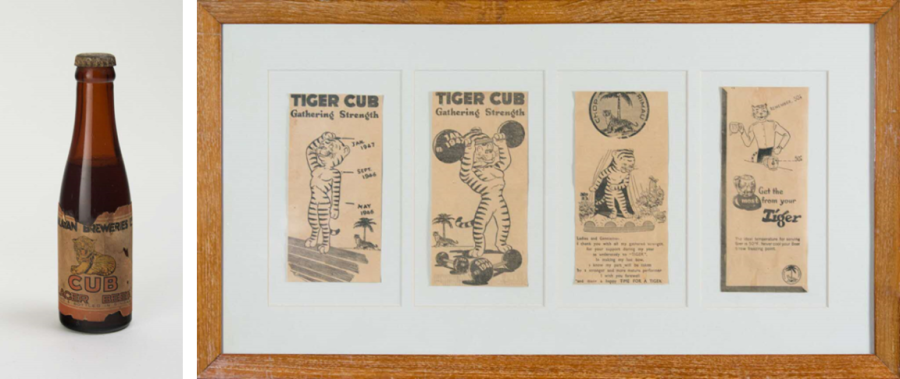 (Left) Tiger Cub was a lighter brew produced in response to a lack of raw ingredients to make the original Tiger Beer. (Right) These ads were published in January 1947 to publicise the return of the original full-strength Tiger Beer. Courtesy of Asia Pacific Breweries Singapore.
(Left) Tiger Cub was a lighter brew produced in response to a lack of raw ingredients to make the original Tiger Beer. (Right) These ads were published in January 1947 to publicise the return of the original full-strength Tiger Beer. Courtesy of Asia Pacific Breweries Singapore.
Postwar and Changes in Sales Strategies
The end of the war saw a boost in beer consumption, with demand largely driven by British troops who preferred local beer to imported beer due to its lower cost – local beer was 65 cents per quart, compared to a dollar for imported beer.29
In 1950, service men in Malaya “drank more than 3,300,000 bottles of N.A.A.F.I beer worth more than $2,500,000” which worked out “to about 14 bottles for each soldier every month” that year.30 They consumed so much beer that, in 1951, beer was described as the “national drink of Malaya” based on sales volume.31
Dr Leonard Bels, the brew master at Malayan Breweries from 1949 to 1974, noted that “[t]hese soldiers are some of our best customers… And mighty drinkers, these soldiers are, too. The British forces here easily take in between 2.5 and 3.5 million cans per month… “. This thirst for local beer had an important impact outside Singapore as well, Bels noted. “[They] take our reputation with them wherever they go. For example, we are doing well in London because British soldiers ask their club manager[s] for Singapore beer. So accustomed are they to the taste.”32
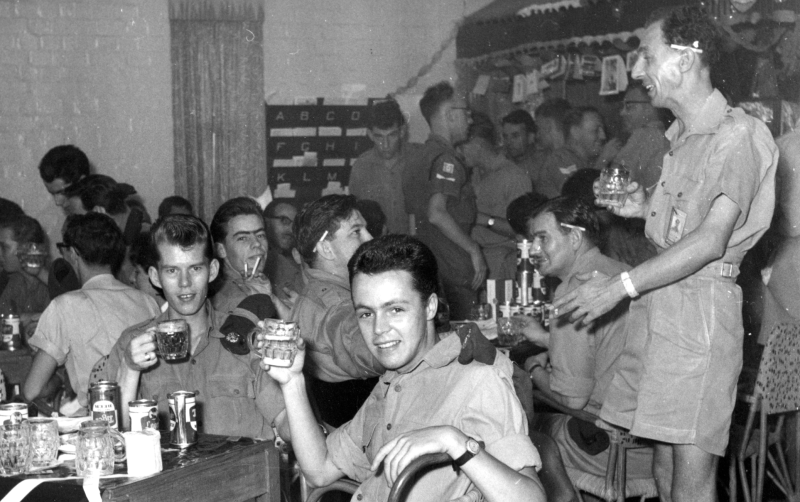 Military personnel enjoying a pint, including Tiger Beer, at the Navy, Army and Air Force Institutes (NAAFI), 1960s. RAFSA Collection, courtesy of National Archives of Singapore.
Military personnel enjoying a pint, including Tiger Beer, at the Navy, Army and Air Force Institutes (NAAFI), 1960s. RAFSA Collection, courtesy of National Archives of Singapore.
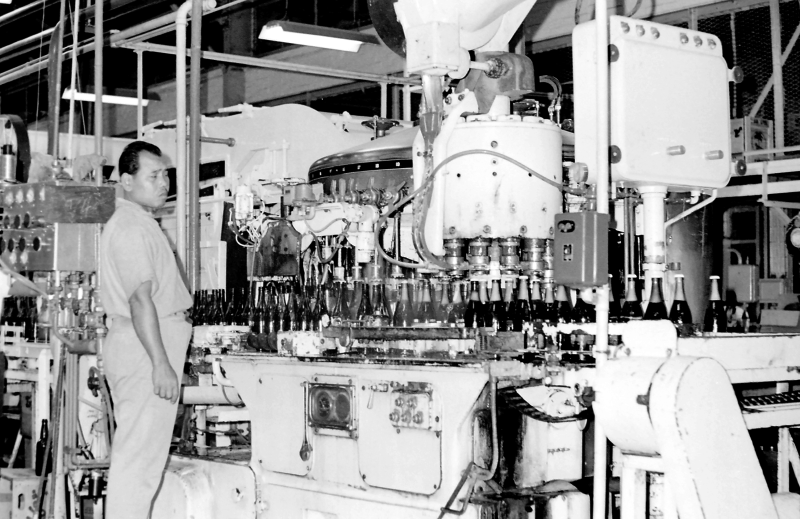 An employee overseeing the filling and bottling of Tiger Beer on the bottling line at the brewery, 1960s. E. Wolters Collection, courtesy of National Archives of Singapore.
An employee overseeing the filling and bottling of Tiger Beer on the bottling line at the brewery, 1960s. E. Wolters Collection, courtesy of National Archives of Singapore.
Malayan Breweries continued to grow from strength to strength. It extended its foothold and influence beyond Singapore and Malaya by acquiring subsidiary companies and breweries in Papua New Guinea in 1955 and New Zealand in 1956.33 By 1968, Tiger Beer was being exported to the U.S, the Middle East, Africa, Bulgaria, Thailand, Indonesia, Australia, and New Zealand.34 By 1981, the company had “reached a new record for beer sales” in beer exports from Singapore, including the production of Heineken and Amstel beer”.35
In 1990, Malayan Breweries changed its name to Asia Pacific Breweries (Singapore) Limited (APB) with a new logo to reflect its global status more accurately.36 In 2013, APB became fully owned by The Heineken Company. Today, Tiger Beer is brewed in 11 countries and available in more than 75. 37 It has even appeared in films such as the Marvel superhero movie The Winter Soldier and the spinechilling horror flick IT Chapter Two.38
APB has had to keep up with the latest trends to appeal to younger customers and remain relevant and competitive. They have engaged K-pop stars as ambassadors and created fresh flavours such as ones infused with soju and even alcohol-free beer.39 With more than 300 beer and cider brands globally under The Heineken Company today, it seems like Singapore’s beer industry is set to keep on brewing.40
LEE KUAN YEW AND ANCHOR BEER
An unlikely presence in the networking sessions, deals, and negotiations of the late Prime Minister Lee Kuan Yew was Anchor beer. He had often offered – and been offered – Anchor to leaders he met.
In his memoir The Singapore Story: Memoirs of Lee Kuan Yew, Volume 1, he recounts his meeting with a communist underground leader. Lee’s purpose was to forge an alliance with communists to gain the support of the Chinese-educated masses in 1961:
“I walked up two flights of stairs of an uncompleted block in darkness. Construction materials still littered the place, and there was no electricity or water. When I entered the candlelit room the girl indicated, the Plen was already waiting. It was furnished only with two armchairs and a table standing between them. He knew I was a beer drinker and provided warm Anchor beer. He opened a bottle, poured me a mug, and topped up his own. He drank first. I hoped I did not show any hesitation before I drank mine.”
Lee also shared how he won the support of political party members through food and Anchor beer: “Throughout 1958–59, I had been seeing Devan Nair, Lim Chin Siong, Fong Swee Suan, Woodhull and Puthucheary in their new detention camp, located just outside Changi Prison, once every three or four weeks. I would bring them a large pot of delicious chicken curry that my cook had prepared, freshly baked bread bought from a bakery on the way to Changi and, when permission was granted, some large bottles of Anchor beer.”
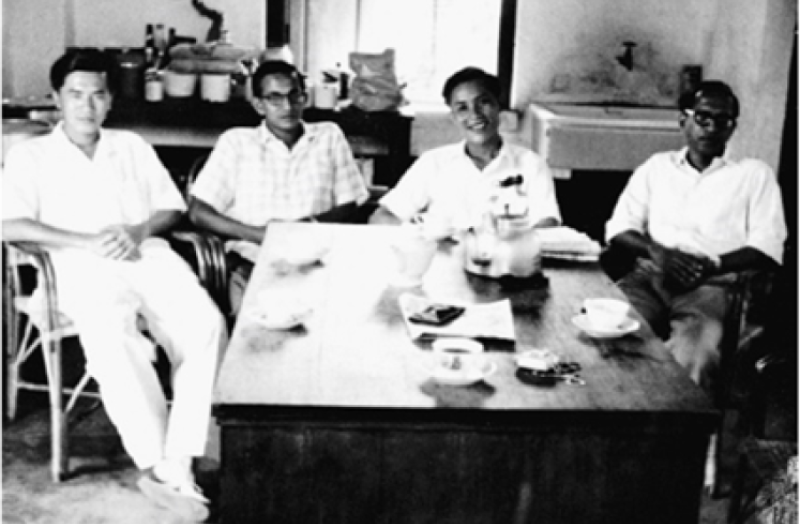 A group photo taken by Lee Kuan Yew when he visited (from left to right) Lim Chin Siong, Sidney Woodhull, Fong Swee Suan and Devan Nair in the Changi detention camp in 1958. Image reproduced from The Singapore Story: Memoirs of Lee Kuan Yew, Volume 1. (Singapore: Marshall Cavendish International Editions, 2012), 381. (From National Library, Singapore, call no. RSING 959.5705092 LEE).
A group photo taken by Lee Kuan Yew when he visited (from left to right) Lim Chin Siong, Sidney Woodhull, Fong Swee Suan and Devan Nair in the Changi detention camp in 1958. Image reproduced from The Singapore Story: Memoirs of Lee Kuan Yew, Volume 1. (Singapore: Marshall Cavendish International Editions, 2012), 381. (From National Library, Singapore, call no. RSING 959.5705092 LEE).
REFERENCE
Lee Kuan Yew, The Singapore Story: Memoirs of Lee Kuan Yew (Marshall Cavendish International, 2014), 379, 466. (From National Library, Singapore, call no. RSING 959.5705092 LEE)
About Author: Ho Sie Sie is a Manager at the Resource Discovery and Management, National Library Board. She is trained to tap a glass of Tiger Beer at 45 degrees to get the ideal layer of foam.
Notes
- “Singapore Beer Industry Outlook 2022-2026,” Reportlinker, accessed 5 September 2023, https://www.reportlinker.com/clp/country/87/726413. ↩
- “Page 3 Advertisements Column 1,” Daily Advertiser, 22 May 1894, 3. (From NewspaperSG) ↩
- “Indian Labour Wages ‘More than Fair’,” Straits Budget, 4 May 1939, 14. (From NewspaperSG) ↩
- “New Industry for Singapore,” Straits Times, 12 April 1904, 5. (From NewspaperSG) ↩
- Alvin Chua, “Fraser & Neave (F&N),” Singapore Infopedia, published 2011. ↩
- “Know Your Company,” Straits Times, 7 January 1984, 24. (From NewspaperSG) ↩
- “130 Years of History in a Heineken Bottle,” Straits Times, 24 April 1994, 9. (From NewspaperSG) ↩
- “A Wonderful Achievement,” Straits Times, 30 September 1932, 12. (From NewspaperSG) ↩
- “Free Beer!, Straits Times, 3 October 1932, 6. (From NewspaperSG) ↩
- “First Brewery in Malaya,” Singapore Free Press, 8 October 1935, 6. (From NewspaperSG) ↩
- Malayan Breweries Limited, Annual Report (Singapore: Malayan Breweries, 1975), 19. (From National Library, Singapore, call no. RCLOS 338.4766342 MBAR) ↩
- Nicolas Khong, “STB and Tiger Beer in First Big Joint Campaign to Promote Singapore,” Today, 14 June 2019, https://www.todayonline.com/singapore/stb-and-tiger-beer-first-big-joint-campaign-promote-singapore. ↩
- “First Concern of Its Kind in Malaya,” Singapore Free Press, 3 May 1935, 34. (From NewspaperSG) ↩
- Malayan Breweries Limited, Annual Report (Singapore: Malayan Breweries, 1989), 1989, 6. (Available via PublicationSG) ↩
- “Tiger’s Rival,” Singapore Free Press, 6 November 1933, 3. (From NewspaperSG) ↩
- “Phoenix Aerated Water Works,” Malaya Tribune, 10 January 1936, 14. (From NewspaperSG) ↩
- “Page 6 Advertisements Column 3,” Singapore Free Press, 27 January 1934, 6. (From NewspaperSG) ↩
- “Government Selling a Gift from Hitler,” Morning Tribune, 21 May 1940, 6. (From NewspaperSG) ↩>
- “Government Selling a Gift from Hitler.” ↩
- National Heritage Board, “Former Archipelago Brewery Company,” National Heritage Board, last updated 2 November 2021, https://www.roots.gov.sg/en/places/places-landing/Places/landmarks/my-queenstown-heritage-trail/former-archipelago-brewery-company. ↩
- “Malaya Buys More Liquor Since War,” Straits Times, 10 January 1940, 10. (From NewspaperSG). Wartime taxes implemented during that period added 50 cents to the price of a quart bottle of champagne, 92 cents to port, sherry and other sweet still wines, 13 cents to claret and other still white wines, 42 cents to a quart of whiskey and between 3 to 5 cents to a bottle of local or foreign beer. ↩
- “20,000,000 Bottles Every Year,” Singapore Free Press, 24 August 1949, 4. (From NewspaperSG) ↩
- “Time for a Tiger,” Shonan Times (Syonan Shimbun), 2 April 1942, 3. (From NewspaperSG) ↩
- Jocelyn Simon De Souza, oral history interview by Yogini Yogarajah, 11 November 1981, MP3 audio, Reel/Disc 2 of 4, National Archives of Singapore (accession no. 000126). ↩
- De Souza, oral history interview, reel/disc 2 of 4. ↩
- De Souza, oral history interview, reel/disc 2 of 4. ↩
- De Souza, oral history interview, reel/disc 2 of 4. ↩
- APB Stories, “Tiger Cub,” accessed 5 September 2023, https://apbstories.com/stories/tiger-cub/. ↩
- “B.O.R.s Drank 3.3 Mil Bottles Beers Last Year,” Straits Times, 4 February 1951, 5. (From NewspaperSG) ↩
- “B.O.R.s Drank 3.3 Mil Bottles Beers Last Year.” ↩
- “Beer Becomes National Drink,” Singapore Standard, 28 June 2951, 9. (From NewspaperSG) ↩
- “The Golden Brew of Dr Bels,” Straits Times, 11 August 1968, 11. (From NewspaperSG) ↩
- “The Growth of Malayan Breweries,” Straits Times, 17 November 1962, 8. (From NewspaperSG) ↩
- “The Golden Brew of Dr Bels.” ↩
- “Record Beer Sales,” Straits Times, 27 July 1981, 4. (From NewspaperSG) ↩
- “M Breweries Changes Name, Logo,” Business Times, 13 March 1990, 3. (From NewspaperSG) ↩
- “Asia Pacific,” The Heineken Company (Cambodia), accessed 31 October 2023, https://www.heinekencambodia.com/asia-pacific. ↩
- “Tiger Beer Product Placement Database”, Product Placement Blog, accessed 31 October 2023, https://productplacementblog.com/tag/tiger-beer/. ↩
- “Our Story,” APB Singapore, accessed 31 October 2023, https://www.apbsingapore.com.sg/who-we-are/. ↩
- “Meet the Tigers,” Tiger Beer, accessed 4 January 2024, https://www.tigerbeer.com/sg/en/agegate?returnUrl=https%3A%2F%2Fwww.tigerbeer.com%2Fsg%2Fen%2Four-beers. ↩